All about magma and
lava
First, there is a definition we need to
make. Just to keep things straight, geologists use the word "magma"
for molten rock that is still underground; and the word "lava"
when it has reached the surface.
How do
magma form?
Rocks in the mantle and the core are still hot from the
formation of the Earth about 4.6 billion years ago. When the Earth formed,
material collided at high speeds. These collisions generated heat and was trapped in the Earth. There is also
heat within the earth produced by radioactive decay of naturally occurring
radioactive elements. It is the same process that allows a nuclear reactor to
generate heat, but in the earth, the radioactive material is much less
concentrated. However, because the earth is so much bigger than a nuclear power
plant it can produce a lot of heat. Rocks are good insulators so the heat has
been slow to dissipate.
This heat is enough to partially melt some rocks in the
upper mantle, about 50-100 km below the surface. We say partially melt because
the rocks don't completely melt. Most rocks are made up of more than one
mineral, and these different minerals have different melting temperatures. This
means that when the rock starts to melt, some of the minerals get melted to a
much greater degree than others. The main reason this is important is that the
magma that is generated is not just the molten equivalent of the starting rock,
but something different. You could think of making a "rock" out of sugar,
butter, and shaved ice. Pretend that they are mixed equally so that your rock is
1/3 sugar, 1/3 butter, and 1/3 shave ice. If you start melting this
"rock", the "magma" that is generated will be
highly concentrated in the things that melt more easily, namely the ice (now
water) and butter. There will be a little bit of molten sugar in your magma, but
not much, most of it will still be crystalline. The most common type of magma produced is basalt (the
stuff that is erupted at mid-ocean ridges to make up the ocean floors, as well
as the stuff that is erupted in Hawaii). Soon after they're formed, little drops
of basaltic magma start to work their way upward (their density is slightly less
than that of the solid rock), and pretty soon they join with other drops and
eventually there is a good flow of basaltic magma towards the surface. If it
makes it to the surface, it will erupt as basaltic lava.
What is lava made up of?
|
Element
(Symbol)
|
Weight
percent
|
|
Oxygen
(O)
|
46.6
|
|
Silicon
(Si)
|
27.7
|
|
Aluminum
(Al)
|
8.1
|
|
Iron
(Fe)
|
5.0
|
|
Calcium
(Ca)
|
3.6
|
|
Sodium
(Na)
|
2.8
|
|
Potassium
(K)
|
2.6
|
|
Magnesium
(Mg)
|
2.1
|
|
Total:
|
98.5
|
Lava is made up
of crystals, volcanic glass,
and bubbles (volcanic gases). As
magma gets closer to the surface and cools, it begins to crystallize minerals
like olivine and form bubbles of volcanic gases. When lava erupts it is made up
of a slush of crystals, liquid, and bubbles. The liquid "freezes" to
form volcanic glass. Chemically lava is made of the
elements silicon, oxygen, aluminum, iron, magnesium, calcium, sodium, potassium,
phosphorus, and titanium (plus other elements in very small concentrations).
Lava
is red hot when it pours or blasts out of a vent but soon changes to dark red,
gray, black, or some other color as it cools and solidifies. Very hot, gas-rich
lava containing abundant iron and magnesium is fluid and flows like hot tar,
whereas cooler, gas-poor lava high in silicon, sodium, and potassium flows
sluggishly, like thick honey in some cases or in others like pasty, blocky
masses.
Types of Lava
The two
most important properties of lava are its viscosity, and the amount of gases
dissolved in the liquid rock. Viscosity
is a term that describes the fluidity or "runniness" of the lava.
The
viscosity of lava depends on several factors. One of the most important factors
is composition, especially the amount of silica (SiO2
or quartz) melted in the lava. Silica molecules have the tendency to stick
together to form long chains. These long chains literally get tangled together
and make it difficult for molecules in the melt to slide past each other. This
slowing of movement at the molecular level makes the whole lava less fluid. A
small difference in silica content can make a huge difference in viscosity:
lavas with about 70% silica (called rhyolites) are about 10 billion times
stiffer than lavas with about 50% silica (called basalts).
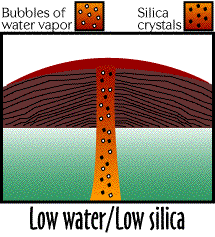
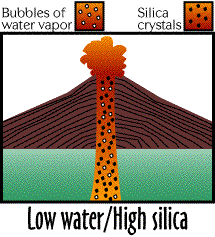 Some
lavas are very "runny," not quite like water, but more like warm honey
or hot wax. When these lavas erupt, they flow for large distances before cooling
enough to turn solid. You can imagine what kind of volcanic mountain you could
make with runny lavas by thinking about (or carefully doing) pouring hot wax on
a large sheet of paper. The wax spreads out into a large, flat layer. Let it
cool and harden and then pour another layer. The second "flow" of wax
will partly pond on the first and partly run off onto the paper to form another
flat layer. If you keep pouring more and more "flows," you will get a
large, but almost flat pile of wax. Therefore, many small eruptions of runny
lavas form large, almost flat mountains like shield volcanoes. Eruptions of huge
amounts of really runny lavas form flood
basalt type volcanoes. Other lavas are very "pasty" like soft clay and hardly flow at
all. Imagine piling lumps of soft ice cream on a big, flat dish--you would end
up with a tall, narrow pile. Likewise, pasty lavas form tall, steep-sided
mountains like stratovolcanoes.
Some
lavas are very "runny," not quite like water, but more like warm honey
or hot wax. When these lavas erupt, they flow for large distances before cooling
enough to turn solid. You can imagine what kind of volcanic mountain you could
make with runny lavas by thinking about (or carefully doing) pouring hot wax on
a large sheet of paper. The wax spreads out into a large, flat layer. Let it
cool and harden and then pour another layer. The second "flow" of wax
will partly pond on the first and partly run off onto the paper to form another
flat layer. If you keep pouring more and more "flows," you will get a
large, but almost flat pile of wax. Therefore, many small eruptions of runny
lavas form large, almost flat mountains like shield volcanoes. Eruptions of huge
amounts of really runny lavas form flood
basalt type volcanoes. Other lavas are very "pasty" like soft clay and hardly flow at
all. Imagine piling lumps of soft ice cream on a big, flat dish--you would end
up with a tall, narrow pile. Likewise, pasty lavas form tall, steep-sided
mountains like stratovolcanoes.
The
other important property of lavas governing the type of eruption is the amount
of gases dissolved in the lava. The most important gases in lavas are water and
carbon dioxide. Although water is a liquid at room temperature, it is
definitely a gas at typical lava temperatures of 900 C (1600 F) to 1200 C (2200
F). Very little gas can be dissolved in lava at the low pressures (around one
atmosphere) found at the surface of the earth. We say the solubility of gases in
liquids is low at low pressures. On the other hand, deep in the earth where
lavas are formed the pressures are high (thousands to millions of atmospheres),
and significant amounts of gas can be dissolved in the lavas (up to several per
cent by weight). We say the solubility of gas in liquids is high at high
pressures. If we dissolve lots of gas in a lava at high pressure and high
solubility and then lower the pressure to get low solubility, the gas will
"undissolve" (or "exsolve") from the liquid to form bubbles.
So what
happens to the gases in lava when it rises from the deep interior of the earth
to the volcano on the surface? Let's consider a couple of everyday examples.
Look at a clear plastic bottle of soda pop that hasn't been opened or recently
shaken. Most soda pop contains a few per cent by weight of dissolved carbon
dioxide. Even if you look carefully at the liquid, you can't see any gas inside
(remember, it is dissolved) except perhaps a few small bubbles and a tiny air
pocket at the top. If you carefully open the bottle, many small bubbles quickly
form and rise to the top and escape. If enough bubbles form, they take part of
the liquid with them as a foam that flows out of the top. If you shake the
bottle vigorously just before opening it, you trigger the formation of so many
bubbles so quickly that the soda pop bursts explosively from the top, and you
and everyone around you are sprayed with fine droplets of liquid. On the other
hand, if the bottle of soda pop is left open for a long time, virtually all of
the dissolved gas escapes, and no amount of shaking can cause the remaining
liquid to spray out. It can only be poured out.
This
shows the effect of dissolved gases. What about viscosity? Think
about making bubbles by blowing air through a straw into a glass of liquid. If
the liquid is water (low viscosity), the bubbles you form escape easily. If you
blow slowly (representing small amounts of escaping gas), the water is little
disturbed. Even if you blow vigorously (representing large amounts of escaping
gas), the water froths and bounces around a lot, but very little gets out of the
glass. If you try the same thing with an ice cream soda or malt (representing
high viscosity), bubbles escape only with difficulty. Even small bubbles
bursting from a malt can get blebs of ice cream on your clothes. Blowing
vigorously can launch the entire malt across the room!
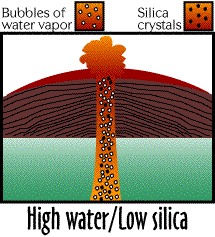
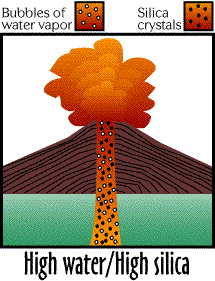 Different
types of lava show behaviors that are similar to our analogies of blowing
bubbles in water or a milk shake. If an erupting lava has low viscosity (like
water) and little or no dissolved gases, it simply flows out of the central vent
and spreads far and wide over the surface (low water/low silica). If it has high viscosity (like a milk shake)
and no dissolved gases, the lava oozes slowly out to form a bulbous dome which
hardly moves at all (low water/high silica). In either case, you could stand nearby in
relative safety. If the erupting lava has lots of dissolved gases, the gases
come out of solution and form bubbles as the lava approaches the surface. If the
viscosity of the lava is low, the lava bubbles and froths a great deal right at
the surface, tossing out tiny cinders and larger "bombs" of lava that
quickly cool and fall back to the ground. This type of eruption (high
water/low silica) produces a spectacular "fire fountain"
directly over the vent, usually resulting in a cinder cone. Any remaining lava quietly flows away.
However,
the last combination, lots of dissolved gases and high viscosity, is deadly (high water/high silica). As the lava oozes to the surface, the gases
quickly form bubbles that turn the lava into a red-hot froth that explodes out
of the ground as a searing, grayish cloud of superheated steam and tiny
particles called ash. The ash forms when the walls of the gas bubbles burst into
tiny fragments. This type of lava causes explosive eruptions at volcanoes like Vesuvius
and Mount St. Helens.
Different
types of lava show behaviors that are similar to our analogies of blowing
bubbles in water or a milk shake. If an erupting lava has low viscosity (like
water) and little or no dissolved gases, it simply flows out of the central vent
and spreads far and wide over the surface (low water/low silica). If it has high viscosity (like a milk shake)
and no dissolved gases, the lava oozes slowly out to form a bulbous dome which
hardly moves at all (low water/high silica). In either case, you could stand nearby in
relative safety. If the erupting lava has lots of dissolved gases, the gases
come out of solution and form bubbles as the lava approaches the surface. If the
viscosity of the lava is low, the lava bubbles and froths a great deal right at
the surface, tossing out tiny cinders and larger "bombs" of lava that
quickly cool and fall back to the ground. This type of eruption (high
water/low silica) produces a spectacular "fire fountain"
directly over the vent, usually resulting in a cinder cone. Any remaining lava quietly flows away.
However,
the last combination, lots of dissolved gases and high viscosity, is deadly (high water/high silica). As the lava oozes to the surface, the gases
quickly form bubbles that turn the lava into a red-hot froth that explodes out
of the ground as a searing, grayish cloud of superheated steam and tiny
particles called ash. The ash forms when the walls of the gas bubbles burst into
tiny fragments. This type of lava causes explosive eruptions at volcanoes like Vesuvius
and Mount St. Helens.
Volcanoes
erupt four basic types of magma: Basalt, Andesite, Dacite, and Rhyolite. The
type of magma erupted determines how explosive the volcano will be. Magma erupts
either as a non-explosive lava flow, or as an explosive eruption of ash and
pumice. The
type of lava is determined by the percentage of silica in the lava. Rhyolite
contains the most silica, Basalt, the least. The higher the silica content, the
stiffer the lava. The lower the silica content, the more fluid the lava.
Basalt
lava, which contains less than 58% silica, is very fluid. It moves along the
ground in long streams, such as this Hawaiian flow. Mount St. Helens has had
eruptions in the past like this, such as the one that formed Ape Cave. In
contrast, Mount St. Helens can also erupt dacite lava that contains about 64%
silica. Instead
of flowing across the ground like basalt lava, dacite lava can pile up right
above the vent, or be erupted explosively, like during the May 18, 1980
eruption. It often forms a mound of lava called a lava dome. Magma
can produce a very explosive eruption if it has a high silica content and a high
concentration of gas. This explosion breaks the magma into pumice and tiny ash
particles. This happened during the May 18th eruption of Mount St. Helens. Brilliant
fountains of basaltic lava, like these, are also the result of gas escaping from
the magma. The gas is released less explosively because basalt has a lower
silica content than dacite.
A
volcano's shape is usually determined by the type of lava it erupts most often.
Basalt lava builds long, broad volcanoes called shield volcanoes. The
stiffer lavas, dacite, andesite, and rhyolite, form steep-sided volcanoes called
composite volcanoes. Mount St. Helens is a composite volcano.
There are three types of basalt lava
flows: pillow, pahoehoe, and aa.
Pillow lava is volumetrically the most
abundant type because they are erupted at mid-ocean ridges (under water or ice)
and because they make up the submarine portion of seamounts and large intraplate
volcanoes, like the Hawaii-Emperor seamount chain. They are often considered
important when trying to decipher old rock sequences because they indicate the
presence of water. However, you have to be very careful to make sure that you
are not looking at regular old pahoehoe toes, which indicate dry
land.
Many of the features that supposedly can be used to tell the difference
between the two don't always work. The only absolute way to know that you are
looking at true pillow lava is to find water-lain sediments between the
individual pillows. Actually, when lava is flowing under water, there is a lot
of sediment generated as pieces of the lava fall off during the rapid collapsing
of the pillows as the quickly chill. Pillow lava is essentially the underwater
equivalent of pahoehoe. They form from low effusion-rate eruptions of fluid
basalt lava. They have a rounder form than pahoehoe toes, mainly because of the
ability of water to help buoy them up (gravity doesn't flatten them out so
much). Also, pillow lava tend to have thicker skins of glass (because they are
quenched more quickly), less vesicular skins (because even shallow water
pressure is able to prevent bubbles from expanding very much), and generally
radial fractures (in contrast to the generally concentric flow banding seen in
pahoehoe toes), compared with pahoehoe toes. Nevertheless, it is often difficult
to tell the two types of lava apart in exposures. The only way to absolutely
know that the flows you're looking at are pillow lava rather than pahoehoe toes,
is to find submarine sediments (such as hyaloclastite debris formed from the
violent reaction of lava and water) between the pillows.
 A picture of pillow lava
A picture of pillow lava
"Pahoehoe"
and "aa" are Hawaiian words
that describe lava. Pahoehoe lava is characterized by a smooth, billowy, or ropy
surface. It is the second most abundant type of lava flow. Pahoehoe flows tend
to be relatively thin, from a few inches to a few feet thick. In map-view the
flows tend to be narrow and elongate.
 Pahoehoe near the
coast of Kilauea by Steve Mattox, 1989.
Pahoehoe near the
coast of Kilauea by Steve Mattox, 1989.
Aa
is
characterized by a rough, jagged, spinose, and generally clinkery surface. Aa
lava flows tend to be relatively thick compared to pahoehoe flows. If lava cools slowly and does not move too fast it forms
smooth ropy lava called pahoehoe. If
it cools quickly and moves fast it can tear into clinkery pieces called aa.
Temperature and gases certainly influence whether the lava
becomes aa or pahoehoe. Probably the two biggest factors are viscosity and rate
of shear strain. Viscosity is just how sticky something is (how much it resists
flowing). An example of rate of shear strain is how quickly or slowly force is
applied across a deck of cards. Factors influencing viscosity or rate of shear
strain are temperature, flow velocity and duration, gas content, flow
dimensions, lava vesicularity, ground slope, crystallinity, channel
configuration.
Two general conditions that determine whether pahoehoe or
aa forms are suggested:
1.
If lava slows, cools, and stops in direct response to
the corresponding increase in viscosity only, it retains its pahoehoe form.
2.
If lava is forced to continue flowing after a certain
critical relationship between viscosity and rate of shear strain is achieved,
the lava changes to aa.
This critical relationship is called the "transition
threshold." They found that if the rate of shear strain is high, the
transition threshold is reached at a lower viscosity than if the shear strain
rate is low. The converse is also true. If the viscosity of the lava is high, a
relatively low rate of shear strain may achieve the transition threshold, and
the lava changes to aa.
There is no systematic chemical difference between aa and
pahoehoe lava. Lava with the identical compositions can form both aa and
pahoehoe. Lava that have slight chemical differences tend to have different
temperatures and viscosity’s but the
critical factor influencing the transition from pahoehoe to aa is the viscosity
of the lava.
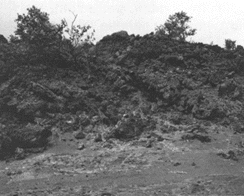

Aa, a
basalt with a rough, blocky appearance, much like furnace slag, is shown
at the left. Pahoehoe, a more fluid variety with a smooth, satiny
and sometimes glassy appearance, is shown at the right.
Other types of lava include block lava, which has a surface of large angular blocks, and
rhyolite. These two types are associated with lava chemistries other than
basalt. They tend to be very thick (10-200 meters) and slow moving.
Measurements of lava

Channel feeding aa lava flow, 1984 eruption of
Mauna Loa. Photograph courtesy of U.S. Geological Survey, March 25, 1984.
Length-- The longest recent flow in Hawaii was erupted from Mauna
Loa in 1859. It is about 51 kilometers long from the vent to the ocean (we don't
know how much longer it went out under water, but probably not too much
farther). There is a lava flow at Undara in Queensland, Australia is 100 miles
(160 km) long. There are lavas called flood basalts that are hundreds of
kilometers long. We don't know too much about how fast they were flowing. Some
people think they were fast-moving, other folks think they were slow. This is an
area of volcanology where lots of research is currently focused. There are lava flows on the Moon, Mars, and Venus that are
several hundreds of kilometers long.
Height-- Lava fountains can propel lava 1,000-2,000 feet (300-600
m) above the volcano. The gas dissolved inside the magma is the driving force.
As the magma approaches the surface the pressure on it decreases. The gas in the
magma starts forming bubbles and the bubbles keep growing larger. The expanding
and bursting bubbles force the lava into the air.
Speed-- In Hawaii the fastest flows we've recorded were those of
the 1950 Mauna Loa eruption. These were going about 6 miles (10 kilometers) per
hour through thick forest. That was the velocity of the flow front. Once the
lava flows became established and good channels developed, the lava in the
channels was going at more like 60 km/hour!
|
Here
is a list of temperatures for the common types of lava:
|
|
Rock
type
|
Temperature
(C)
|
Temperature
(F)
|
|
Rhyolite
|
700-900
|
1292-1652
|
|
Dacite
|
800-1100
|
1472-2012
|
|
Andesite
|
950-1200
|
1742-2192
|
|
Basalt
|
1000-1250
|
1832-2282
|
Temperature--
The temperatures of lavas vary depending on their chemical
composition. Hawaiian lava (basalt) is usually around 1100 C. Volcanoes such as
Mt. St. Helens erupt lava that are around 800 C.
Lava cools very quickly at first and forms a thin crust
that insulates the interior of the lava flow. As a result, basaltic lava flows
can form crusts that are thick enough to walk on in 10-15 minutes but the flow
itself can take several months to cool! Because of the insulating properties of
lava, it cools slower and slower over time. Thick stacks of lava flows (30 m or
100 ft thick) can take years to cool completely. An extreme example is a lava
flow that was erupted in 1959 and partly filled a pit crater (Kilauea Iki). The
"ponded" flow was about 85 meters thick (about 280 ft thick). It was
drilled in 1988, and there was still some mushy, not-quite-solid stuff down near
the bottom, 29 years after it erupted!
Common
questions about lava
How close can I get to lava and will it hurt or
kill me?
How close you can get depends on what kind of lava flow it
is, and whether you are upwind or downwind. For example, the most approachable
lava is pahoehoe. This is because each toe forms an insulating skin seconds
after emerging on the surface. This skin is at first flexible and then hardens,
but even when flexible it is a good insulator. This serves to keep the interior
of an active pahoehoe toe hot and fluid but also prevents you from getting
burned by the radiant heat. If the wind is at your back, you can easily approach
long enough and close enough to get a sample with a hammer. It is still hot, and
unless you are well protected you can only be that close for a minute or so. You
also notice that as soon as you peel the skin off to get at the molten interior,
the heat goes way up. This is heat that you can't stand, you have to get back
otherwise blisters start to form. It is hot enough that you can't accidentally
step on active lava.
Skylights into lava tubes on pahoehoe flows are quite hot,
and have to be approached from upwind. They are so hot that the air shimmers
over them so they are hard to miss. They are dangerous not as much because of
the radiant heat from the lava inside but because of the super-heated plume of
air coming out. You have to be really careful that the wind doesn't shift, and
many a volcanologist has gotten singed skin and hair when the wind changed.
An aa flow is terrible to work near. Instead of a
relatively continuous skin! Aa flows have discontinuous layers of clinker, and a
huge amount of radiant heat escapes from between the clinker. Aa flows also move
faster so you really have to be quick on your feet if you want a sample.
Additionally, aa flows tend to form open channels rather than lava tubes. The
channels can sometimes have completely incandescent surfaces because they are
flowing so fast that any skin that forms is immediately torn or sunk. Some
volcanologist once flew over a large channel in a helicopter. They were at least
200-400 meters above the flow, but as soon as they were over the channel they
could immediately feel the radiant heat through the windows!
Lava won't kill you if it briefly touches you. You would
get a nasty burn, but unless you fell in and couldn't get out, you wouldn't die.
With prolonged contact, the amount of lava "coverage" and the length
of time it was in contact with your skin would be important factors in how
severe your injuries would be. The health of the individual, the amount of time
before care can be given and the quality of that care would also be important.
In fact there have been 2 cases at the Hawaiian Volcano Observatory where a
geologist fell into lava. Fortunately in both instances the lava was not very
deep and they were able to get out quickly. Both ended up in the hospital and it
was a scary and painful experience. Both recovered fine. Little research has
been done on injuries caused by lava. People have been killed by very fast
moving lava flows. A recent example was the 1977 eruption at Nyiragongo.
Why do lava have different colors?
The color of lava depends on its temperature. It starts
out bright orange (1000-1150 C). As it cools the color changes to bright red
(800-1000 C), then do dark red (650-800 C), and to brownish red (500-650 C).
Solid lava is black (but can still be very hot).
It is the same reason that electric stove elements turn
colors. First red then orange when turned on high (don't do that experiment by
yourself). As things get hotter they start to glow, first red, then orange, then
yellow, then green, then blue, then violet. The sun's color, for example, is
sort of yellow-green, but you can't tell by looking at it (and remember, you
should NEVER look at the sun).
What is the greatest amount of lava that has ever
erupted from any volcano?
Probably the largest historic lava flow was erupted in Iceland from part of the Grimsvotn
volcano system called Laki. Thorvaldur Thordarson and Steve Self calculated a
lava flow volume of 14.7 cubic kilometers of lava.


 Some
lavas are very "runny," not quite like water, but more like warm honey
or hot wax. When these lavas erupt, they flow for large distances before cooling
enough to turn solid. You can imagine what kind of volcanic mountain you could
make with runny lavas by thinking about (or carefully doing) pouring hot wax on
a large sheet of paper. The wax spreads out into a large, flat layer. Let it
cool and harden and then pour another layer. The second "flow" of wax
will partly pond on the first and partly run off onto the paper to form another
flat layer. If you keep pouring more and more "flows," you will get a
large, but almost flat pile of wax. Therefore, many small eruptions of runny
lavas form large, almost flat mountains like shield volcanoes. Eruptions of huge
amounts of really runny lavas form flood
basalt type volcanoes.
Some
lavas are very "runny," not quite like water, but more like warm honey
or hot wax. When these lavas erupt, they flow for large distances before cooling
enough to turn solid. You can imagine what kind of volcanic mountain you could
make with runny lavas by thinking about (or carefully doing) pouring hot wax on
a large sheet of paper. The wax spreads out into a large, flat layer. Let it
cool and harden and then pour another layer. The second "flow" of wax
will partly pond on the first and partly run off onto the paper to form another
flat layer. If you keep pouring more and more "flows," you will get a
large, but almost flat pile of wax. Therefore, many small eruptions of runny
lavas form large, almost flat mountains like shield volcanoes. Eruptions of huge
amounts of really runny lavas form flood
basalt type volcanoes. 

 A picture of pillow lava
A picture of pillow lava


